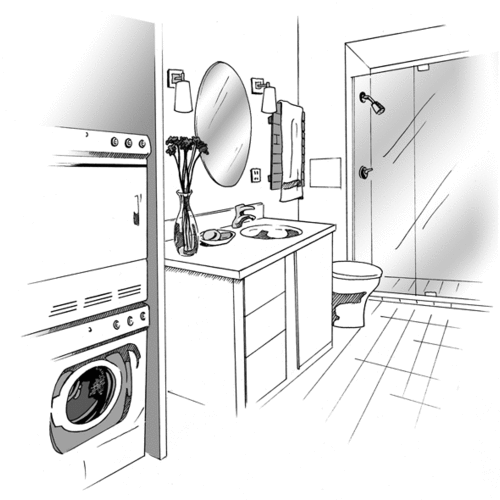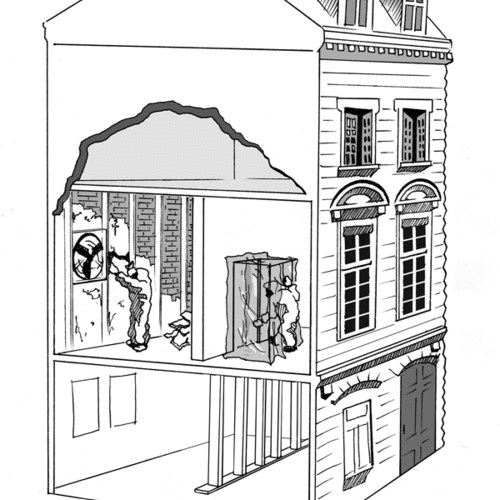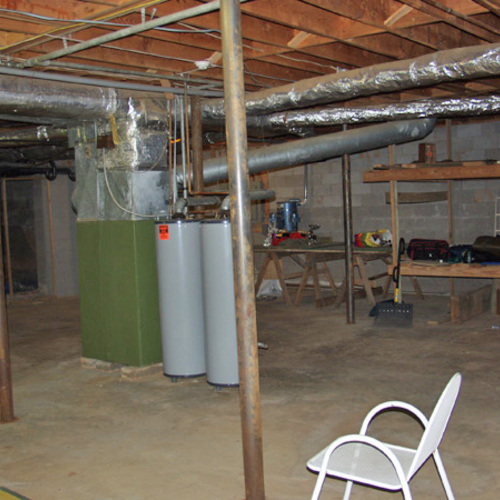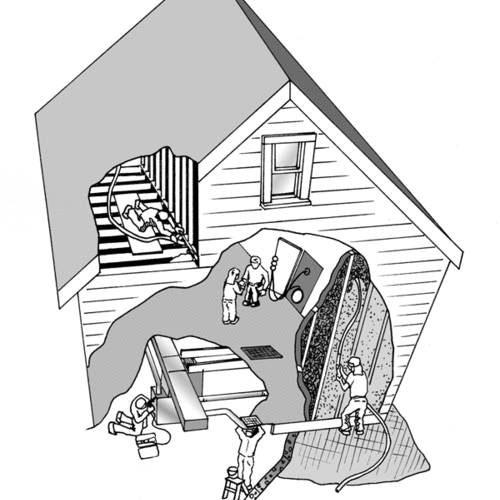Design considerations can save resources
Green materials choices for cabinetry, countertops, finsihes, and flooring are all available, and replacing older energy-hogging appliances and fixtures with newer, more efficient models can significantly reduce utility bills. There are also opportunities for making plumbing runs shorter, which can reduce costs and make hot water delivery more efficient. And finally, keep in mind that a smaller kitchen will be greener than a gargantuan one.
Plan carefully for the busiest room in the house
The easiest way to keep a kitchen remodel green is to keep its size reasonable. Most people use a kitchen for work space, food storage, entertaining, and dining. Take time to understand how you really use the kitchen and its adjacent spaces, and how you’d like that to change. Would an office hutch help control clutter? What about a prep sink in an island? How these wants and needs work together is how efficient space planning happens.
Look at what’s working, and what’s not
What sort of problems result from the existing layout? Is there a bottleneck in traffic patterns? Is there too little countertop near the stove, fridge, or sink? Are the appliances too far from each other? What about comfort issues — are the windows too cold to sit in front of? Are there cold spots and drafts along outside walls? Does the vent hood actually remove polluted air to the outside or is it vented into an attic or back into the room? Do the pipes leak? These fixes must be part of the renovation.
How does the kitchen remodel tie in to other projects you’ve got planned?
For example, the scope of a kitchen remodel might not include the insulation and air sealing the walls, roof, and foundation of the rest of the house, but if the building is extremely leaky, you’d be hard pressed to call any kitchen remodel green without addressing the energy-wasting problems first.
A better kitchen isn’t necessarily a bigger one
If you can refrain from adding more space to the kitchen, either with an addition or re-working interior space, you’ll spend less money and use fewer resources. Of course, adding in is always greener than adding on.
It’s often tempting to make a kitchen bigger and to add more bells and whistles— a second dishwasher, a larger refrigerator, a wine chiller, etc. These features should be carefully weighed against space requirements, energy use, and water use. Even more difficult may be decisions about storage—including countertop space for everyday appliances and concealed storage for small appliances and dry goods. A Green Kitchen Remodel Case Study:
MORE ABOUT KITCHEN REMODELING
LAYOUT/SPACE PLANNING
Ventilate all fans to the outdoors.
Some older recirculating range hoods blow minimally filtered exhaust air right back into the kitchen–sometimes right at your forehead as you’re standing at the stove! Another ventilation shortcut is to vent the fan into the attic or crawlspace above the kitchen. Make sure range hoods and other exhaust fans vent directly to the outside.
Windows and skylights in the kitchen
Windows and skylights can provide natural light, a connection with the out doors, warmth, and fresh air. But they also can overheat rooms in summer and cause leaks in walls and roofs. It’s common, especially in a kitchen, to fill a wall with windows, but it’s a better idea to strategically place the right type of window or skylight for the best views, ventilation and energy performance.
Short and direct plumbing runs save a lot of energy and deliver hot water faster. Plumbing runs are best placed in interior rather than in exterior walls. Placing them in exterior walls makes a house harder to heat and cool, and increases the possibility of mold problems and frozen pipes.
Appliance location
Keep heating heat generating appliances—stoves, ovens, and dishwashers—away from refrigerators. Make sure there’s enough air space around all appliances to vent away ambient heat. It’s also important to keep refrigerators out of the direct sunlight that comes through windows and skylights.
Lighting design
Good lighting design can improve kitchen function, appearance, and energy performance. Get the right mix of task and ambient lighting using energy efficient fixtures wherever possible. And keep recessed lights out of the ceiling if that ceiling is insulated — these can lights are like energy tunnels.
ARE GRANITE COUNTERS A RADON HAZARD?
By Christina Glennnon
There has been considerable debate lately about the possible danger of radon and radiation emission from granite countertops. Granite, formed by the cooling of melted rock, is known to contain varying concentrations of uranium, which can produce radiation and radon gas. Both are known carcinogens: Radon is the number-one cause of lung cancer among nonsmokers, and radiation is linked to any number of cancers as well as to genetic defects in unborn children. Unfortunately, there’s little published research on the subject, leaving the risks of granite countertops up for debate.
W.J. Llope, Ph.D., a senior faculty fellow at the T.W. Bonner Nuclear Laboratory at Rice University, began researching the subject after he was asked to test a home’s countertop by a local news station. He was surprised when the test showed radiation emissions, and began reviewing previous research. According to Llope, there is clear scientific evidence that radiation and radon are emitted from granite. What is unclear is whether the specific stones typically used in kitchen countertops emit the same levels. This question led him to begin his own testing on countertops available for home installations. “Most stones, in terms of radioactivity, are relatively quiet. But there are a couple I have found that are insanely hot,” Llope writes on his Web site.
However, the Marble Institute of America, a trade association representing the natural-stone industry, points to a study it sponsored that found not a single stone emitted radon or radiation levels higher than those commonly found outdoors. Says Guido Gliori, the organization’s president: “To date, all published scientific research on granite shows that radon emissions from those countertops are not even close to posing a health risk.”
Still, to assure consumers of the safety of granite countertops, the institute is developing the Home Approved Stone program, which Gliori describes as “an industry-wide program that will apply uniform, rigorous standards to test and approve granite slabs for indoor use.” The standards, Gliori says, are being re-viewed by the American Association of Radon Scientists and Technicians and the Conference of Radiation Control Program Directors. The label shown above should begin showing up on granite this year.
Although the debate continues, the consensus is that the majority of granite stones pose little risk to homeowners. The U.S. Environmental Protection Agency (EPA), for its part, does not believe sufficient data exists to conclude that the granite used in countertops significantly increases indoor radon levels. As a result, the EPA does not recommend testing just granite countertops for radon, but rather the entire house. “In a nutshell, we believe people need to test the air in their home before getting concerned about granite countertops,” EPA spokesman Dave Ryan writes in an email. “If there is a significant radon [radiation] problem detected in a home, mostly likely the source is coming from soil gas [not from the granite countertops].” Home testing kits for radon can be purchased online or at hardware stores, starting at about $25. For more information, visit the EPA’s Web site.
_Christina Glennon is an editorial assistant at Fine Homebuilding_
One Kitchen Case Study

Adding without adding on
The owners of this 1,200-square-foot, 1948 house in Santa Cruz, California, had an overall plan: remodel their home in a way that would allow them to live out their lives in one place. Because of mold and moisture issues, they had already upgraded the house envelope. Next they wanted to design a kitchen that would last forever, add a guest bathroom, and create a private master bath. The clients were looking for a way to redesign within the existing space of their concrete masonry home and were sold on the idea of building green.
Design Approach

Image Credits: Jonathan Leys, WoodMaster/REGREEN
Borrow from the mudroom to add to the kitchen
The existing kitchen was tiny, poorly laid out, and poorly furnished, but it adjoined a large mudroom. Reconfiguring the floorplan to subdivide the mudroom allowed the designer to expand the kitchen and add a guest bathroom without an addition or significant relocation of walls. Because the owners wanted to grow old in the building, every effort was made to ensure accessibility in the open plan. And although this project did not include a photovoltaic or graywater system, the remodel did include prewiring for a future PV system and preplumbing for graywater.
Systems

Image Credits: Jonathan Leys, WoodMaster/REGREEN
Key Systems
HVAC
* Kitchen range hood exhausted directly outdoors
Lighting
* Ambient lighting: airtight, insulation-contact-rated, recessed fluorescent cans
* Task lighting: under-cabinet fluorescent lights and over-table light fixtures made from 100% recycled cast aluminum
* Meets California’s Title 24 requirements for lighting efficiency
Appliances
* Energy-efficient dishwasher, clothes washer and dryer—
beyond Energy Star minimum
* High-efficiency water heater Wall and Ceiling Finishes
* Zero-VOC paint Floors and Flooring Products
* Natural linoleum flooring
Furniture and Fittings
* Bamboo cabinetry with natural low-VOC finish and prefinished plywood bodies of FSC-certified maple with formaldehyde-free, soy-based adhesive
* Cabinets with recycled plastic content
* Concrete countertops with locally produced natural wax finish
Extra Features
* Prewired for photovoltaic panels
* Preplumbed for graywater system
Lessons

Image Credits: Jonathan Leys, WoodMaster/REGREEN
Award winning green design
The clients wanted to go green all the way and made few compromises. The house is likely to achieve the first green building award in the City of Santa Cruz Green Building Program, meeting 133 to 135 of the 137 points available to this project (the program total for remodeling projects is 464). The designer’s one regret is the high-VOC finish on the hardwood floors throughout the house, which was the owners’ one nongreen choice.
Team & Finances
Team and Process
Considering whether to hire a pro, the do-it-yourself homeowners
were drawn to the unique materials in the Eco Interiors
green showroom, and to Lydia Corser’s deep green approach. Lydia
and contractor Rory Howland are Build It Green trained and certified.
Their common green building background allowed them to
easily form a team, recommending and implementing a wide
range of green features that the clients would not have considered on their own.
Location: Santa Cruz, California
Homeowners: Laura Alderman and Gary Garcia
Interior Designer: Lydia Corser, Eco Interiors
General Contractor: Rory Howland, Howland Construction
Area affected: 250 square feet
Finances
The owners originally wanted to add a granny apartment to their
garage, but the price estimate led them to a remodel instead.
Ultimately, the remodel cost 30% to 60% more than they budgeted
—about the cost of the new construction estimate. What drove the
cost up was the additional work orders and add-ons, not the green
features. Because the owners had decided to move out for the work,
they took the opportunity to do additional upgrades on the house.
GREEN POINTS
LEED for Homes. For gut rehabs that include the kitchen, EA9 (Energy & Atmosphere) offers 1 point for ENERGY STAR refrigerators; 1/2 point for ENERGY STAR dishwashers; MR2.2 (Materials & Resources) offers 1/2 point for environmentally preferable cabinets; 1/2 point for environmentally preferable countertops.
NGBS-Remodel. Refer to the ANSI standard and follow the appropriate path based on conditioned floor area involved in the remodeling or addition project and the year in which the original home was built. NGBS










0 Comments
Log in or create an account to post a comment.
Sign up Log in